unit5短语课文翻译
- 格式:doc
- 大小:34.50 KB
- 文档页数:2
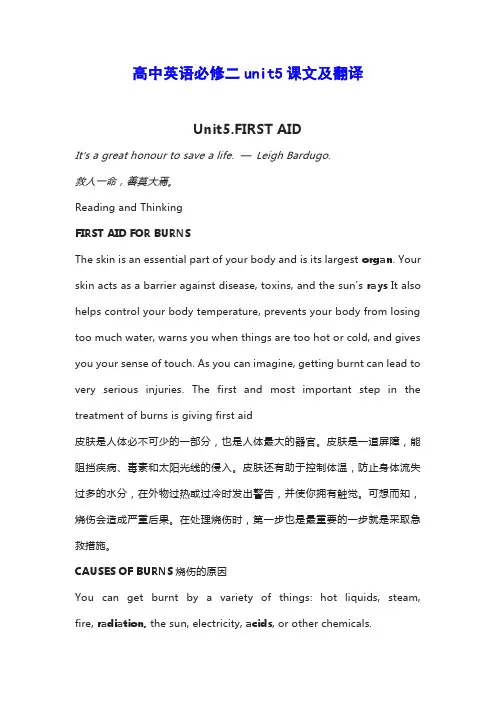
高中英语必修二unit5课文及翻译Unit5.FIRST AIDIt’s a great honour to save a life. —Leigh Bardugo.救人一命,善莫大焉。
Reading and ThinkingFIRST AID FOR BURNSThe skin is an essential part of your body and is its largest organ. Your skin acts as a barrier against disease, toxins, and the sun's rays It also helps control your body temperature, prevents your body from losing too much water, warns you when things are too hot or cold, and gives you your sense of touch. As you can imagine, getting burnt can lead to very serious injuries. The first and most important step in the treatment of burns is giving first aid皮肤是人体必不可少的一部分,也是人体最大的器官。
皮肤是一道屏障,能阻挡疾病、毒素和太阳光线的侵入。
皮肤还有助于控制体温,防止身体流失过多的水分,在外物过热或过冷时发出警告,并使你拥有触觉。
可想而知,烧伤会造成严重后果。
在处理烧伤时,第一步也是最重要的一步就是采取急救措施。
CAUSES OF BURNS烧伤的原因You can get burnt by a variety of things: hot liquids, steam, fire, radiation, the sun, electricity, acids, or other chemicals.很多东西都会造成烧伤:灼热的液体、蒸汽、明火、辐射、太阳光、电流、酸性物质或其他化学品。
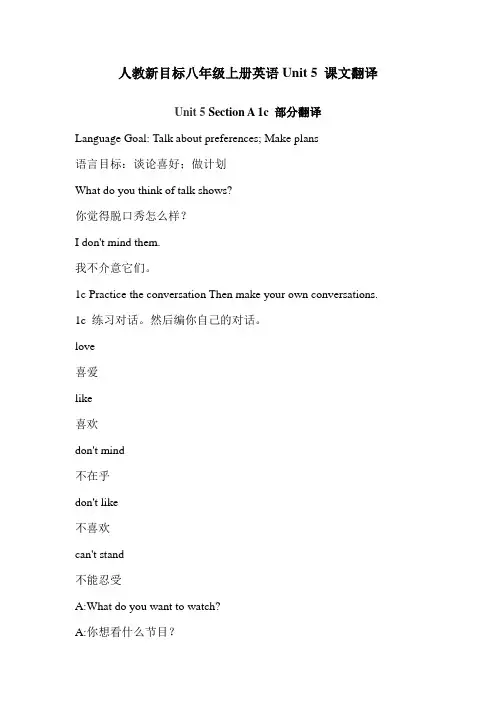
人教新目标八年级上册英语Unit 5 课文翻译Unit 5 Section A 1c 部分翻译Language Goal: Talk about preferences; Make plans语言目标:谈论喜好;做计划What do you think of talk shows?你觉得脱口秀怎么样?I don't mind them.我不介意它们。
1c Practice the conversation Then make your own conversations. 1c 练习对话。
然后编你自己的对话。
love喜爱like喜欢don't mind不在乎don't like不喜欢can't stand不能忍受A:What do you want to watch?A:你想看什么节目?B:What do you think of talk shows?B:你觉得脱口秀怎么样?A:They're OK. I don't mind them.A:还行。
我不介意它们。
B:Then let's watch a talk show.B:那我们就看脱口秀吧。
Unit 5 Section A 2d部分课文翻译Role-play the conversation.分角色表演对话。
Grace:What did you do in class today,Sarah?格蕾丝:你今天上课都做什么了,萨拉?Sarah:We had a discussion about TV shows. My classmates like game shows and sports shows.萨拉:我们讨论了电视节目。
我的同学喜欢游戏节目和体育节目。
Grace: Oh, I can't stand them I love soap operas. I like to follow the story and see what happens next.格蕾丝:哦,我受不了它们。
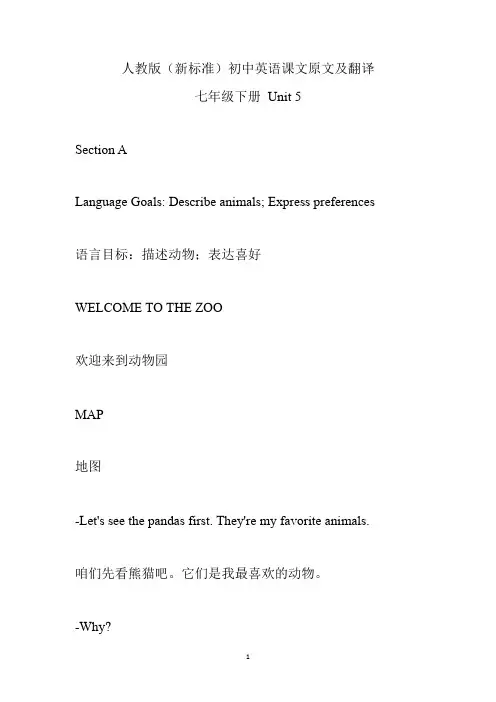
人教版(新标准)初中英语课文原文及翻译七年级下册Unit 5Section ALanguage Goals: Describe animals; Express preferences 语言目标:描述动物;表达喜好WELCOME TO THE ZOO欢迎来到动物园MAP地图-Let's see the pandas first. They're my favorite animals.咱们先看熊猫吧。
它们是我最喜欢的动物。
-Why?为什么?-Because they're very cute.因为它们非常可爱。
2c. Talk about the other two animals in 2a with partner.和同伴谈论2a中的其他两只动物。
Do John and Julie like them? Do you like them? Why or why not?约翰和朱莉喜欢它们吗?你喜欢它们吗?为什么喜欢或为什么不喜欢?2d. Role-play the conversation. 分角色表演对话。
Jenny: Your dog is really cute, Peter!珍妮:你的狗真可爱,彼得!Peter: He's my new pet, Dingding. He's very smart.彼得:他是我的新宠物——丁丁。
他非常聪明。
Jenny: Really? What can he do?珍妮:真的吗?他会做什么?Peter: He can walk on two legs. He can dance, too.彼得:他会用两条腿走路。
他也会跳舞。
Jenny: Wow!珍妮:哇!Peter: Does your family have a pet?彼得:你家有宠物吗?Jenny: My mom has a big cat, but I don't like her.珍妮:我妈妈有一只大猫,但我不喜欢她。
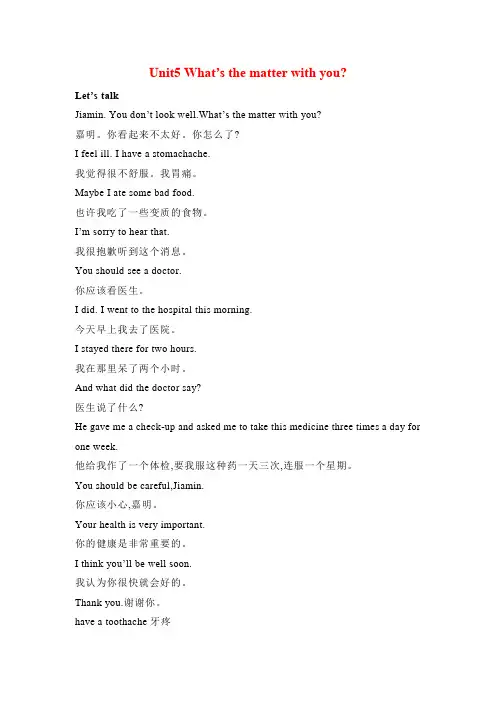
Unit5 What’s the matter with you?Let’s talkJiamin. You don’t look well.What’s the matter with you?嘉明。
你看起来不太好。
你怎么了?I feel ill. I have a stomachache.我觉得很不舒服。
我胃痛。
Maybe I ate some bad food.也许我吃了一些变质的食物。
I’m sorry to hear that.我很抱歉听到这个消息。
You should see a doctor.你应该看医生。
I did. I went to the hospital this morning.今天早上我去了医院。
I stayed there for two hours.我在那里呆了两个小时。
And what did the doctor say?医生说了什么?He gave me a check-up and asked me to take this medicine three times a day for one week.他给我作了一个体检,要我服这种药一天三次,连服一个星期。
You should be careful,Jiamin.你应该小心,嘉明。
Your health is very important.你的健康是非常重要的。
I think you’ll be well soon.我认为你很快就会好的。
Thank you.谢谢你。
have a toothache牙疼eat(ate) too much candy吃(吃)太多的糖果brush teeth twice a day刷牙一天两次have a broken finger的手指断了fall(fell) from my bike下降(下降)我的自行车take a rest休息have a cold 感冒了wear(wore)wet clothes穿(戴)的湿衣服take some medicine吃药have a fever 发烧eat(ate)too much ice cream吃(吃)太多的冰淇淋drink plenty of water喝大量的水have a headache头痛can’t(couldn’t)sleep不能(不)睡眠take some medicine吃药Fun with language有趣的语言2.Listen and tick or cross.–Ben,Ben,wake up.It’s a quarter past seven now.– Morning,mum.–What’s the matter with you?–I am very tired. I don’t feel well.– Let me see.Oh,you have a fever.– I think so.But I must go to school.We’ll have something important to do.–You can’t to to school today.Let’s go to the hospital.Now,get up and have breakfast first.– OK.( )1.It’s 7:15 now.( )2.Ben and him mum are having breakfast.( )3.Ben has a fever.( )4.Ben doesn’t wan t to go to school.( )5.Ben and his mum will go to see the doctor.Rhyme time押韵Read the rhyme阅读押韵Go to bed early早点上床睡觉Go to bed early-wake up with joy.早睡——醒来心情好Go to bed late-cross girl and boy.迟睡——见谁都烦恼Go to bed early-ready for play.早睡——学习很轻松Go to bed late-moping all day.迟睡——闷闷不快乐Go to bed early-no pains or ills.早睡——无痛百病消Go to bed late-doctors and pills.迟睡——求医又吃药Go to bed early-grow very tall.早睡——个头长得高Go to bed late-stay very small.迟睡——总是矮又小。
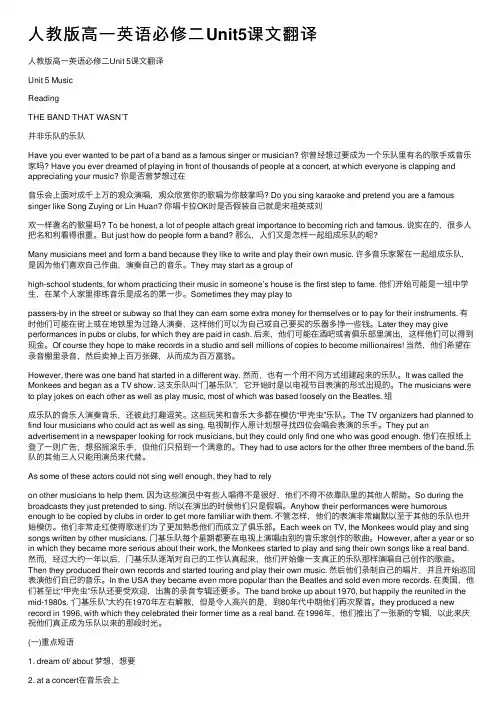
⼈教版⾼⼀英语必修⼆Unit5课⽂翻译⼈教版⾼⼀英语必修⼆Unit 5课⽂翻译Unit 5 MusicReadingTHE BAND THAT WASN’T并⾮乐队的乐队Have you ever wanted to be part of a band as a famous singer or musician? 你曾经想过要成为⼀个乐队⾥有名的歌⼿或⾳乐家吗? Have you ever dreamed of playing in front of thousands of people at a concert, at which everyone is clapping and appreciating your music? 你是否曾梦想过在⾳乐会上⾯对成千上万的观众演唱,观众欣赏你的歌唱为你⿎掌吗? Do you sing karaoke and pretend you are a famous singer like Song Zuying or Lin Huan? 你唱卡拉OK时是否假装⾃⼰就是宋祖英或刘欢⼀样著名的歌星吗? To be honest, a lot of people attach great importance to becoming rich and famous. 说实在的,很多⼈把名和利看得很重。
But just how do people form a band? 那么,⼈们⼜是怎样⼀起组成乐队的呢?Many musicians meet and form a band because they like to write and play their own music. 许多⾳乐家聚在⼀起组成乐队,是因为他们喜欢⾃⼰作曲,演奏⾃⼰的⾳乐。
They may start as a group ofhigh-school students, for whom practicing their music in someone’s house is the first step to fame. 他们开始可能是⼀组中学⽣,在某个⼈家⾥排练⾳乐是成名的第⼀步。
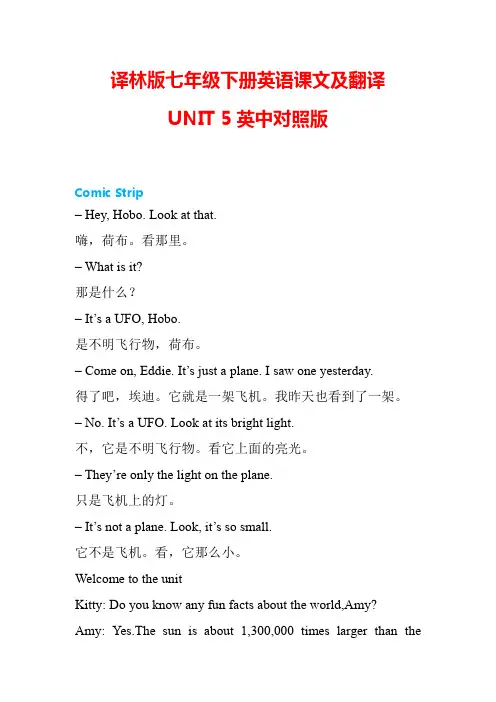
译林版七年级下册英语课文及翻译UNIT 5英中对照版Comic Strip– Hey, Hobo. Look at that.嗨,荷布。
看那里。
– What is it?那是什么?– It’s a UFO, Hobo.是不明飞行物,荷布。
– Come on, Eddie. It’s just a plane. I saw one yesterday.得了吧,埃迪。
它就是一架飞机。
我昨天也看到了一架。
– No. It’s a UFO. Look at its bright light.不,它是不明飞行物。
看它上面的亮光。
– They’re only the light on the plane.只是飞机上的灯。
– It’s not a plane. Look, it’s so small.它不是飞机。
看,它那么小。
Welcome to the unitKitty: Do you know any fun facts about the world,Amy? Amy: Yes.The sun is about 1,300,000 times larger than theEarth.Kitty: That’s interesting! What about fish,Amy?Amy: Fish sleep with their eyes open.Kitty: Oh,really?Amy: Yes. Isn’t that amazing?七下· p58ReadingThe ghost in the park公园里的鬼One Sunday morning, Millie and Amy went to Sunshine Park.As usual, they sat under a big tree.周日的早上,米莉和艾米去阳光公园。
她们像平常一样坐在一棵大树下面。
Suddenly, they heard a whisper from the bushes behind the tree.They turned around but saw nothing.’Is anybody there?’ Millie asked. Nobody replied.”That’s strange,” the two girls were very afraid. They left the park quickly.On their way home, they met Andy.突然,她们听到低语声从大树后面的灌木丛传出来。
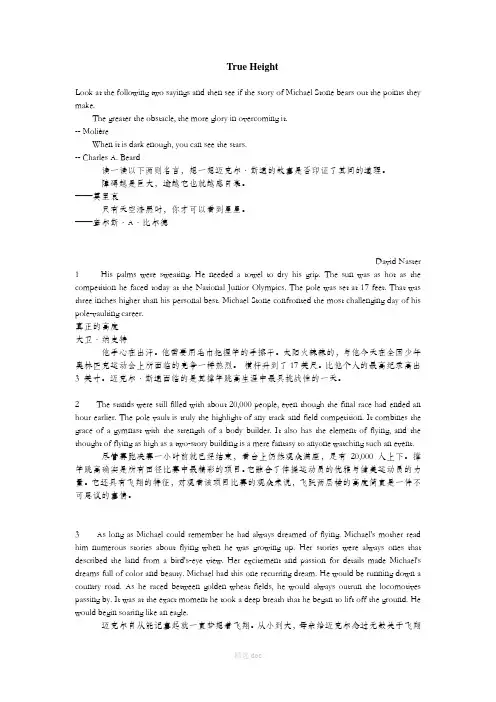
True HeightLook at the following two sayings and then see if the story of Michael Stone bears out the points they make.The greater the obstacle, the more glory in overcoming it.-- MolièreWhen it is dark enough, you can see the stars.-- Charles A. Beard读一读以下两则名言,想一想迈克尔·斯通的故事是否印证了其间的道理。
障碍越是巨大,逾越它也就越感自豪。
——莫里哀只有天空漆黑时,你才可以看到星星。
——查尔斯·A·比尔德David Naster 1 His palms were sweating. He needed a towel to dry his grip. The sun was as hot as the competition he faced today at the National Junior Olympics. The pole was set at 17 feet. That was three inches higher than his personal best. Michael Stone confronted the most challenging day of his pole-vaulting career.真正的高度大卫·纳史特他手心在出汗。
他需要用毛巾把握竿的手擦干。
太阳火辣辣的,与他今天在全国少年奥林匹克运动会上所面临的竞争一样热烈。
横杆升到了17英尺。
比他个人的最高纪录高出3 英寸。
迈克尔·斯通面临的是其撑竿跳高生涯中最具挑战性的一天。
2 The stands were still filled with about 20,000 people, even though the final race had ended an hour earlier. The pole vault is truly the highlight of any track and field competition. It combines the grace of a gymnast with the strength of a body builder. It also has the element of flying, and the thought of flying as high as a two-story building is a mere fantasy to anyone watching such an event.尽管赛跑决赛一小时前就已经结束,看台上仍然观众满座,足有20,000人上下。
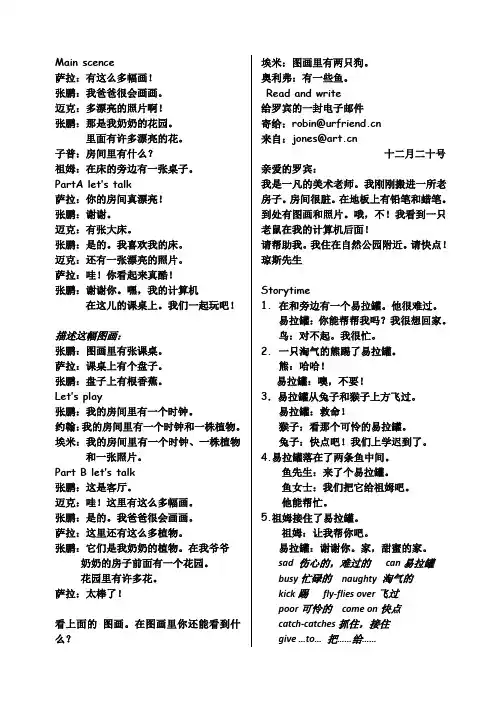
Main scence萨拉:有这么多幅画!张鹏:我爸爸很会画画。
迈克:多漂亮的照片啊!张鹏:那是我奶奶的花园。
里面有许多漂亮的花。
子普:房间里有什么?祖姆:在床的旁边有一张桌子。
PartA let’s talk萨拉:你的房间真漂亮!张鹏:谢谢。
迈克:有张大床。
张鹏:是的。
我喜欢我的床。
迈克:还有一张漂亮的照片。
萨拉:哇!你看起来真酷!张鹏:谢谢你。
嘿,我的计算机在这儿的课桌上。
我们一起玩吧!描述这幅图画:张鹏:图画里有张课桌。
萨拉:课桌上有个盘子。
张鹏:盘子上有根香蕉。
Let’s play张鹏:我的房间里有一个时钟。
约翰:我的房间里有一个时钟和一株植物。
埃米:我的房间里有一个时钟、一株植物和一张照片。
Part B let’s talk张鹏:这是客厅。
迈克:哇!这里有这么多幅画。
张鹏:是的。
我爸爸很会画画。
萨拉:这里还有这么多植物。
张鹏:它们是我奶奶的植物。
在我爷爷奶奶的房子前面有一个花园。
花园里有许多花。
萨拉:太棒了!看上面的图画。
在图画里你还能看到什么?埃米:图画里有两只狗。
奥利弗:有一些鱼。
Read and write给罗宾的一封电子邮件寄给:robin@来自:jones@十二月二十号亲爱的罗宾:我是一凡的美术老师。
我刚刚搬进一所老房子。
房间很脏。
在地板上有铅笔和蜡笔。
到处有图画和照片。
哦,不!我看到一只老鼠在我的计算机后面!请帮助我。
我住在自然公园附近。
请快点!琼斯先生Storytime1.在和旁边有一个易拉罐。
他很难过。
易拉罐:你能帮帮我吗?我很想回家。
鸟:对不起。
我很忙。
2.一只淘气的熊踢了易拉罐。
熊:哈哈!易拉罐:噢,不要!3.易拉罐从兔子和猴子上方飞过。
易拉罐:救命!猴子:看那个可怜的易拉罐。
兔子:快点吧!我们上学迟到了。
4.易拉罐落在了两条鱼中间。
鱼先生:来了个易拉罐。
鱼女士:我们把它给祖姆吧。
他能帮忙。
5.祖姆接住了易拉罐。
祖姆:让我帮你吧。
易拉罐:谢谢你。
家,甜蜜的家。
sad 伤心的,难过的can易拉罐busy忙碌的naughty 淘气的kick踢fly-flies over飞过poor可怜的come on快点catch-catches抓住,接住give …to… 把……给……注:1.an apple/an orange/an umbrella(伞)/an eggan English book/ an old house2.不可数名词:water/juice/milk/tea/Coke/Cola/coffeemeat(肉)/chicken/fish/soup/rice/beef/bread注:人+have/has+物品。
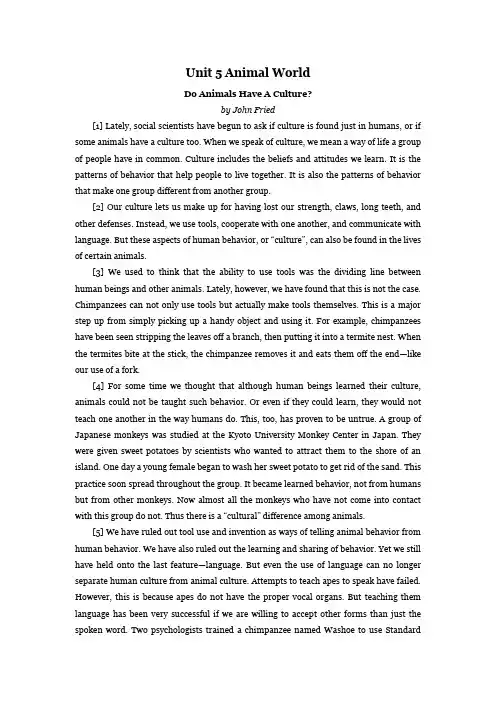
Unit 5 Animal WorldDo Animals Have A Culture?by John Fried[1] Lately, social scientists have begun to ask if culture is found just in humans, or if some animals have a culture too. When we speak of culture, we mean a way of life a group of people have in common. Culture includes the beliefs and attitudes we learn. It is the patterns of behavior that help people to live together. It is also the patterns of behavior that make one group different from another group.[2] Our culture lets us make up for having lost our strength, claws, long teeth, and other defenses. Instead, we use tools, cooperate with one another, and communicate with language. But these aspects of human behavior, or “culture”, can also be found in the lives of certain animals.[3] We used to think that the ability to use tools was the dividing line between human beings and other animals. Lately, however, we have found that this is not the case. Chimpanzees can not only use tools but actually make tools themselves. This is a major step up from simply picking up a handy object and using it. For example, chimpanzees have been seen stripping the leaves off a branch, then putting it into a termite nest. When the termites bite at the stick, the chimpanzee removes it and eats them off the end—like our use of a fork.[4] For some time we thought that although human beings learned their culture, animals could not be taught such behavior. Or even if they could learn, they would not teach one another in the way humans do. This, too, has proven to be untrue. A group of Japanese monkeys was studied at the Kyoto University Monkey Center in Japan. They were given sweet potatoes by scientists who wanted to attract them to the shore of an island. One day a young female began to wash her sweet potato to get rid of the sand. This practice soon spread throughout the group. It became learned behavior, not from humans but from other monkeys. Now almost all the monkeys who have not come into contact with this group do not. Thus there is a “cultural” difference among animals.[5] We have ruled out tool use and invention as ways of telling animal behavior from human behavior. We have also ruled out the learning and sharing of behavior. Yet we still have held onto the last feature—language. But even the use of language can no longer separate human culture from animal culture. Attempts to teach apes to speak have failed. However, this is because apes do not have the proper vocal organs. But teaching them language has been very successful if we are willing to accept other forms than just the spoken word. Two psychologists trained a chimpanzee named Washoe to use StandardAmerican Sign Language. This is the same language used by deaf people. In this language, “talk” is made through gestures, and not by spelling out w ords with individual letters. By the time she was five years old, Washoe had a vocabulary of 130 signs. Also, she could put them together in new ways that had not been taught her originally. This means she could create language and not just mimic it. She creates her own sentences that have real meaning. This has allowed two-way talk. It permits more than one-way command and response.[6] Of course, there are limits to the culture of animals. As far as we know, no ape has formed social institutions such as religion or law. Also, some chimpanzees may be able to learn sign language, but this form of language is limited in its ability to communicate abstract ideas. Yet with a spoken language we can communicate our entire culture to anyone else who knows that language. Perhaps the most important thing is that the line dividing us from them is not as clear as we used to think.动物拥有文化吗?1 只有人类拥有文化呢,还是某些动物也同样拥有文化,这是社会科学家们最近才提出来的问题。
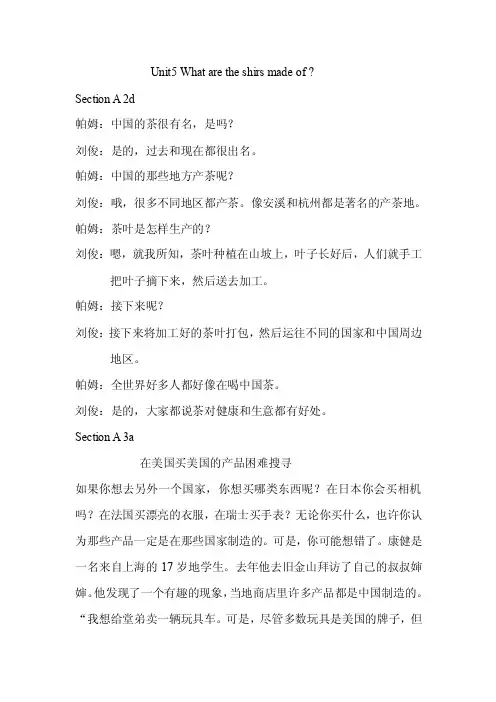
Unit5 What are the shirs made of ?Section A 2d帕姆:中国的茶很有名,是吗?刘俊:是的,过去和现在都很出名。
帕姆:中国的那些地方产茶呢?刘俊:哦,很多不同地区都产茶。
像安溪和杭州都是著名的产茶地。
帕姆:茶叶是怎样生产的?刘俊:嗯,就我所知,茶叶种植在山坡上,叶子长好后,人们就手工把叶子摘下来,然后送去加工。
帕姆:接下来呢?刘俊:接下来将加工好的茶叶打包,然后运往不同的国家和中国周边地区。
帕姆:全世界好多人都好像在喝中国茶。
刘俊:是的,大家都说茶对健康和生意都有好处。
Section A 3a在美国买美国的产品困难搜寻如果你想去另外一个国家,你想买哪类东西呢?在日本你会买相机吗?在法国买漂亮的衣服,在瑞士买手表?无论你买什么,也许你认为那些产品一定是在那些国家制造的。
可是,你可能想错了。
康健是一名来自上海的17岁地学生。
去年他去旧金山拜访了自己的叔叔婶婶。
他发现了一个有趣的现象,当地商店里许多产品都是中国制造的。
“我想给堂弟卖一辆玩具车。
可是,尽管多数玩具是美国的牌子,但他们都是中国制造的。
”不光玩具是中国制造的。
“我想买一双篮球鞋。
”他解释道,“我找了五到六个商店才找到一双美国制造的!他感觉美国人想不买中国产品几乎不可能。
他接着说:“事实上,那里太多中国制造的东西————足球、手提包、宠物食品、手机,甚至美国国旗都是中国制造的!”康健觉得中国能制造这些日用品是件好事,不过他希望将来有一天中国更擅于制造高科技产品,让世界各地的人们都能买到。
Section B 2b普通物件中的美中国每个不同地区都有自己独特的传统艺术品。
这些艺术品通常表达的是那些生活中重要的东西,诸如爱、美和家庭。
最普通的东西,从纸到黏土到竹子,都能变成美丽的物品。
根据中国历史,孔明灯最早就是诸葛孔明在身处困境的时候来寻求帮助的。
现在,孔明灯用于过节和其他庆祝活动。
孔明灯用竹子做成,竹子外面用纸包裹。
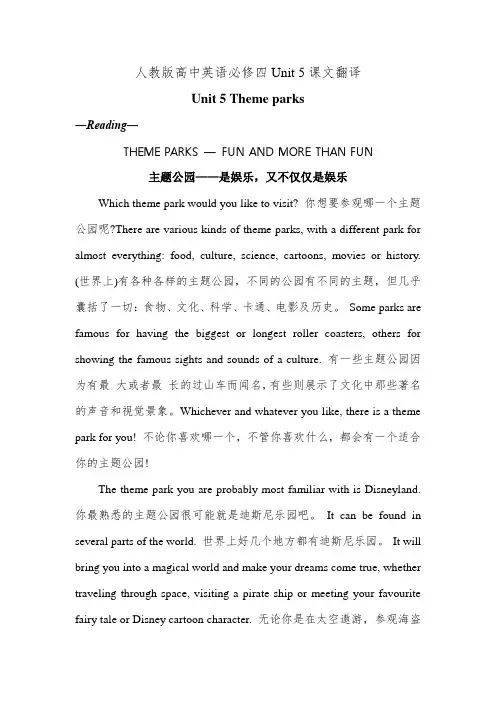
人教版高中英语必修四Unit 5课文翻译Unit 5 Theme parks―Reading―THEME PARKS —FUN AND MORE THAN FUN主题公园——是娱乐,又不仅仅是娱乐Which theme park would you like to visit? 你想要参观哪一个主题公园呢?There are various kinds of theme parks, with a different park for almost everything: food, culture, science, cartoons, movies or history. (世界上)有各种各样的主题公园,不同的公园有不同的主题,但几乎囊括了一切:食物、文化、科学、卡通、电影及历史。
Some parks are famous for having the biggest or longest roller coasters, others for showing the famous sights and sounds of a culture. 有一些主题公园因为有最大或者最长的过山车而闻名,有些则展示了文化中那些著名的声音和视觉景象。
Whichever and whatever you like, there is a theme park for you! 不论你喜欢哪一个,不管你喜欢什么,都会有一个适合你的主题公园!The theme park you are probably most familiar with is Disneyland. 你最熟悉的主题公园很可能就是迪斯尼乐园吧。
It can be found in several parts of the world. 世界上好几个地方都有迪斯尼乐园。
It will bring you into a magical world and make your dreams come true, whether traveling through space, visiting a pirate ship or meeting your favourite fairy tale or Disney cartoon character. 无论你是在太空遨游,参观海盗船,还是邂逅你最喜欢的童话故事或者迪斯尼卡通里的人物,迪斯尼会把你带入一个魔幻的世界,使你的梦想变成现实。
译林版三年级下册Unit5(含中文翻译)Unit 5 How old are you?你多大了?Story timePage32-33① Look! 看!How lovely!多么可爱啊!②How old are you?你多大了?I’m nine.我九岁。
③This is for you.这是给你的。
Thank you.谢谢。
④How old are you?你多大了?I’m eight.我八岁。
I’m two. 我两岁。
⑤Here you are .给你。
Thank you.谢谢。
Thank you.谢谢。
单词one一two 二three 三four 四five 五six 六 seven七eight 八nine 九ten 十Cartoon time ①Happy birthday, Sam! What a nice cake! 生日快乐,山姆!多么漂亮的一个蛋糕!②How old are you, Sam?你多大了,山姆?I’m two. 我两岁。
③Make a wish ,Sam.许个愿,山姆。
④I want a robot .我想要一个机器人。
⑤I want a toy car. I want ……我想要一个玩具汽车,我想要……⑥Sam! It’s time for the cake!山姆,到吃蛋糕的时间了!单词how old are you 你多大?lovely 可爱的 nine 九 eight八 four 四 five 五 six六 seven 七 ten 十right 对的;正确的out 出局What a nice cake! 多么漂亮的蛋糕啊!make a wish. 许个愿吧。
want 想要;想It’s time for…是……的时候了。
重点内容短语:how lovely 多么可爱how old 多大,几岁惯用语:1. Thank you.谢谢你(们)。
2. Here you are.给你(们)。
Unit5课文翻译课文AWill you be a worker or a laborer?你想做工作者还是劳役者?1.一个人要想真正快乐,必须觉得自己既自由又重要。
如果觉得自己是受社会逼迫而做自己不喜欢的工作,或者自己喜欢的工作被认为没价值或不重要而遭社会忽视,那他绝不会快乐。
在一个奴隶制度严格说来已经被废除的社会里,工作的社会含义、工作的价值和薪水,已经把许多劳役者降格为现代奴隶——“薪奴”。
2.如果人们的工作对自己有负面的影响,但为了遵从社会的期望或者挣钱养家糊口而被迫必须继续工作,那么他们就被认为是劳役者。
劳役的对立面是玩乐。
当我们玩游戏时,我们很享受正在做的事情,但这仅仅是个人娱乐。
社会对我们何时玩乐或者是否玩乐并不关心。
3.处于劳役和玩乐之间的就是工作。
如果人们的个人兴趣跟社会付酬让他们做的工作相吻合,他们就被称为工作者。
社会上看来一定是苦工的事情对个人来说却是自在的玩乐活动。
一份活到底应定为工作还是劳役并不取决于其本身,而是承担这份活的个人感受。
比如,二者的区别与是体力活还是脑力活或尊严的高低没有关联。
温室里满身尘土的园丁可能是工作者,而衣冠楚楚的市长则可能是一个不开心的劳役者!4.人们对自己工作的态度决定了一切。
对工作者而言,闲暇只是为了更有效地工作而需要放松休息的时间。
因此,工作者更倾向于投入更多的时间工作,而花在休闲上的时间并非很多,而是很少。
而对劳役者而言,休闲意味着从被迫状态中得到自主。
因此,他们自然会想,花在劳作上的时间越少,自在玩乐的时间越多,则越好。
5.除了花在闲暇上的时间不同,工作者和劳役者的区别还在于他们从工作中获得的个人满足感不同。
工作者喜欢自己的工作,感觉更快乐,更轻松,通常对自己的生活更满意。
他们工作起来也会更勤奋,更精细,因为他们对自己的工作已经产生了一种自豪感。
相反,由于劳役者的唯一动力是挣生活费,他们觉得每天花在苦差上的时间是一种浪费,不会让自己快乐。
人教版高一英语必修二Unit 5课文翻译Unit 5 MusicReadingTHE BAND THAT WASN’T并非乐队的乐队Have you ever wanted to be part of a band as a famous singer or musician? 你曾经想过要成为一个乐队里有名的歌手或音乐家吗? Have you ever dreamed of playing in front of thousands of people at a concert, at which everyone is clapping and appreciating your music? 你是否曾梦想过在音乐会上面对成千上万的观众演唱,观众欣赏你的歌唱为你鼓掌吗? Do you sing karaoke and pretend you are a famous singer like Song Zuying or Lin Huan? 你唱卡拉OK时是否假装自己就是宋祖英或刘欢一样著名的歌星吗? To be honest, a lot of people attach great importance to becoming rich and famous. 说实在的,很多人把名和利看得很重。
But just how do people form a band? 那么,人们又是怎样一起组成乐队的呢?Many musicians meet and form a band because they like to write and play their own music. 许多音乐家聚在一起组成乐队,是因为他们喜欢自己作曲,演奏自己的音乐。
They may start as a group ofhigh-school students, for whom practicing their music in someone’s house is the first step to fame. 他们开始可能是一组中学生,在某个人家里排练音乐是成名的第一步。
译林版八年级上册英语课文及翻译UNIT 5英中对照版UNIT 5ic stripWould you like to live in the wild, Eddie?你想要住在荒野吗,艾迪?No.不想。
Why not? Wild animals are free and happy.为什么不?野生动物很自由也很快乐。
I don't think so. They may bee dishes on the table any time.我不这样认为。
它们随时都可能成为餐桌上的美食。
So could you please not eat them?所以你能不吃它们吗?No way!不可能!Please have pity on them, Eddie.请怜悯一下它们吧。
I may die without them.没有它们我可能会死的。
In fact, these are not wild animals, Hobo.事实上,这些不是野生动物,荷布。
ReadingThe story of Xi Wang希望的故事I first saw the baby panda when she was only ten days old.我第一次见到这只小熊猫的时候,她只有十天大。
We called her Xi Wang.我们叫她希望。
This means "hope".它的意思是“希望”。
When Xi Wang was born, she weighed just 100 grams and looked like a white mouse.希望出生的时候,她只有100克重,看起来像只小白鼠。
At four months old, she weighed about eight kilograms and started to go outside for the first time.四个月的时候,她重约八公斤,并且第一次外出。
译林版五年级下册Unit5(含中⽂翻译)Unit 5 Story time①It is Saturday morning. My father is cleaning the car. I am helping him. My mother iscooking breakfast in the kitchen. Helen is in the living room. She is sweeping the floor.Where is Tim? What is he doing now? Tim is in his bedroom. He is sleeping.Ben the dog issleeping too. 这是星期六早晨。
我爸爸正在擦车。
我正在帮助他。
我妈妈正在厨房⾥做早饭。
海伦在客厅⾥。
她正在扫地。
蒂姆在哪⾥?他现在正在做什么?蒂姆在他的卧室⾥。
他正在睡觉。
(⼩)狗本也正在睡觉。
②In the afternoon, my cousin Jim comes. What are we doing now? My mother is busy.She is cooking dinner. Helen and I are helping her. Helen is washing the dishes. I amcleaning the table. 下午,我表弟吉姆来了。
我们现在正在做什么?我妈妈很忙。
她正在做晚饭。
海伦和我正在帮助她。
海伦正在洗碗。
我正在擦桌⼦。
③ What are Tim and Jim doing? They are eating fruit in the living room.蒂姆和吉姆正在做什么?他们正在客厅⾥吃⽔果。
We're watching TV too! 我们也正在看电视! Woof! 汪!Wordsclean the car 洗车 clean the table擦桌⼦make the bed 铺床sweep the floor 拖地wash clothes 洗⾐ wash thedishes 洗盘⼦Sound time Ingbring 带来morning 早上sing 唱歌spring 春天In the morning, I like to sing在早上,我喜欢唱歌。
班级 组 组 姓 —〇————————装—————〇——————————订——————————〇——————线—————〇—
单词:
情景喜剧 _______新闻节目;新闻 _______肥皂剧 _______介意;对(某亭) 烦恼
_______忍受;站立_______教育的;有教育意义的 _______打算;计划 _______希_______讨论;商量 _______发生;出现 _______预料;期待 _______笑话;玩笑 _______喜剧片_______认为_______从 获得向 学习 _______查明,弄清楚_______访谈节目 ______________游戏节目 _______肥皂剧 _______发生 _______ 看电影_______毫无意义的;意思不明确的 _______行动 _______动画片:卡通片 _______文化;文明 _______有名的, 出名的 _______出现 _______开始变得; 变成 _______ 富有的 _______获得成功的;有成就的 _______ 可能;可以 _______主要的_______原因,理由 _______普通的;常见的_______电影_______不幸的;不吉利的_______失去;丢失_______女朋友 _______准备好的 _______人物角色_______简单的,易做的_______陆军; 军部队
_______之一 _______—双;一对 _______ 尽某人最大努力 _______看起来像 ______________ 与……一样有名 _______例如 _______的象征 _______装扮 _______代替某人 _______干得好 _______令人愉快的事情
班级 组 组 姓 —〇————————装—————〇——————————订——————————〇——————线—————〇—。